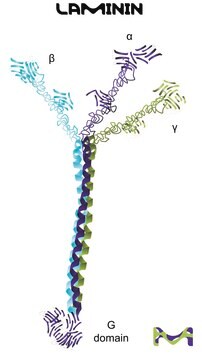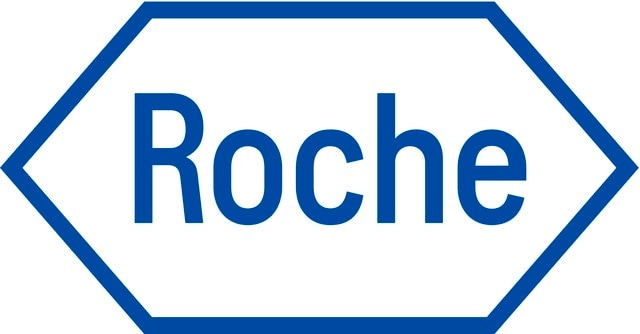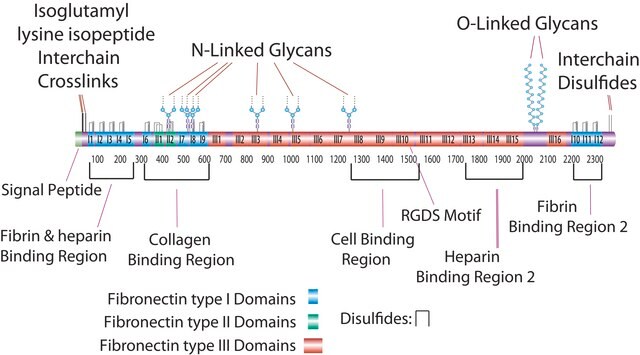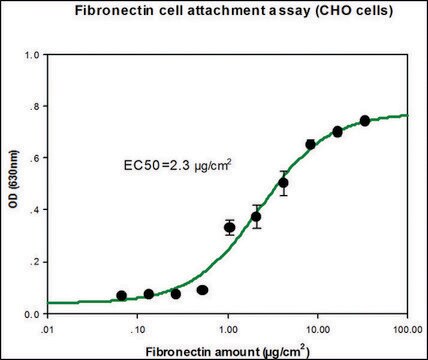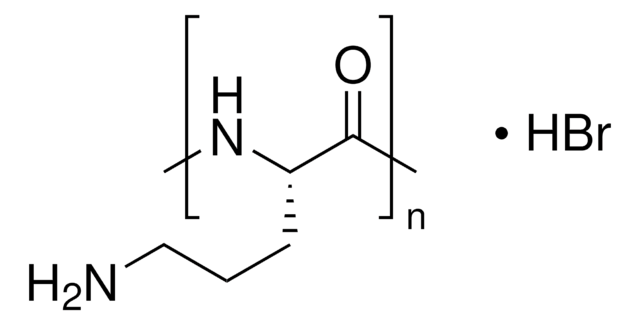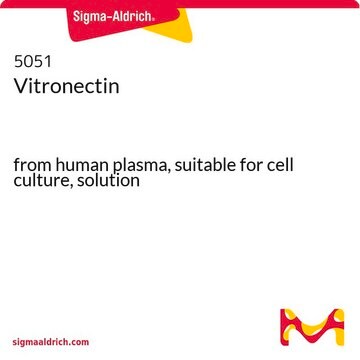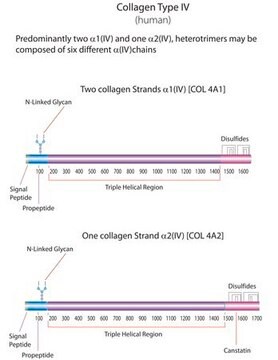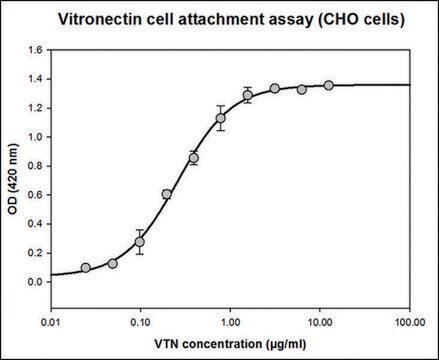추천 제품
제품명
Laminin from human fibroblasts, cell culture derived, liquid, sterile-filtered
생물학적 소스
human fibroblasts
Quality Level
무균
sterile-filtered
양식
liquid
포장
pkg of 100 μL
기술
cell culture | mammalian: suitable
표면 범위
1‑2 μg/cm2
UniProt 수납 번호
결합 특이성
Peptide Source: Collagen
배송 상태
dry ice
저장 온도
−70°C
유전자 정보
human ... LAMB1(3912)
애플리케이션
Laminin from human fibroblasts has been used:
Laminin from human fibroblasts is recommended for use as a cell culture substratum at 1-2 μg/cm2. The optimal concentration does depend on cell type as well as the application or research objectives.
- in coating six-well plates for wound healing assay
- as a substrate in cell adhesion and spreading assay
- for differentiation of human embryonic stem cells (hESCs) and human induced pluripotent stem cells (hiPSCs) toward dopaminergic neurons
- in corneal endothelial cell wound healing (migration) assay and corneal endothelial cell barrier assay
Laminin from human fibroblasts is recommended for use as a cell culture substratum at 1-2 μg/cm2. The optimal concentration does depend on cell type as well as the application or research objectives.
생화학적/생리학적 작용
Laminin proteins are integral components of structural scaffolding in animal tissues. They associate with type IV collagen via entactin and perlecan and bind to cell membranes through integrin receptors, dystroglycan glycoprotein complexes and Lutheran blood group glycoproteins. Laminin has active domains for collagen binding, cell adhesion, heparin binding, and neurite outgrowth fragment. Laminin supports growth and differentiation of many cell types including epithelial, endothelial, neural, muscle and liver cells.
성분
Laminin is an extracellular matrix multidomain trimeric glycoprotein, and is the main non-collagenous component of basal lamina that supports adhesion, proliferation and differentiation. Laminin is composed of both A, B1 and B2 chains, which are connected by many disulfide bonds. This laminin product is produced by human fibroblasts and epithelial cells in a co-culture system and then purified biochemically.
주의사항
It is recommended to store this product at -70°C, where it will remain stable for two years.
제조 메모
This product is supplied at a concentration of 0.5 mg/mL in TBS. Thaw this solution slowly before use at 2-8°C to avoid gel formation. If at any time prior to that, the laminin is allowed to warm up prematurely, gelling can occur. Moreover, even allowing it to be stored at -20C can induce gelling or significantly reduce its activity or both." For use as a coating, dilute in a HBSS, coat culture surface with a minimal volume and incubate at 37°C for 1-2 hours. Wash 3 times with HBBS before plating cells. Laminin coatings can be stored for one month at 2-8°C.
Storage Class Code
10 - Combustible liquids
WGK
WGK 2
Flash Point (°F)
Not applicable
Flash Point (°C)
Not applicable
이미 열람한 고객
Elucidating the molecular basis of PPCD: Effects of decreased ZEB1 expression on corneal endothelial cell function
Zakharevich M, et al.
Molecular Vision, 740-740 (2017)
Serum-induced differentiation of glioblastoma neurospheres leads to enhanced migration/invasion capacity that is associated with increased MMP9
Joseph JV, et al
PLoS ONE, 10(12), e0145393-e0145393 (2015)
Highly efficient neural conversion of human pluripotent stem cells in adherent and animal-free conditions
Lukovic D, et al.
Stem Cells Translational Medicine, 6(4), 1217-1226 (2017)
PRL-3 engages the focal adhesion pathway in triple-negative breast cancer cells to alter actin structure and substrate adhesion properties critical for cell migration and invasion
Gari HH, et al.
Cancer letters, 380(2), 505-512 (2016)
Danielle K Lewis et al.
Aging cell, 7(6), 836-849 (2008-09-10)
Astrocytes comprise a large proportion of the central nervous system support cells and play a critical role in neural injury and repair. The present study examined the impact of ovarian aging using an ex vivo model system, where astrocytes were
문서
Attachment Factors for 3-Dimensional Cell Culture
The extracellular matrix (ECM) is secreted by cells and surrounds them in tissues.
Extracellular matrix proteins such as laminin, collagen, and fibronectin can be used as cell attachment substrates in cell culture.
자사의 과학자팀은 생명 과학, 재료 과학, 화학 합성, 크로마토그래피, 분석 및 기타 많은 영역을 포함한 모든 과학 분야에 경험이 있습니다..
고객지원팀으로 연락바랍니다.